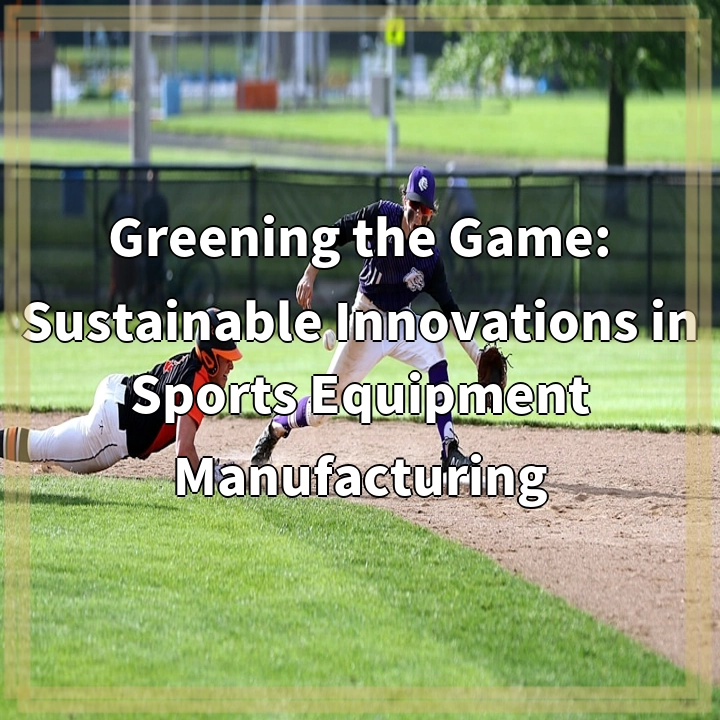
What it is:
Sustainable Innovations in Sports Equipment Manufacturing refer to the efforts made by manufacturers to minimize their environmental impact and promote sustainability throughout the production process of sports equipment. This includes adopting eco-friendly materials, improving manufacturing techniques, and incorporating various green initiatives to reduce carbon emissions, waste generation, and resource consumption.
Real-World Problems:
Despite the growing interest in sustainable initiatives, the sports equipment manufacturing industry faces several challenges in its journey towards becoming more environmentally friendly.
1. Material Selection:
The choice of materials used in sports equipment can have a significant ecological impact. Many conventional materials, such as plastics and synthetic fibers, are derived from fossil fuels and contribute to greenhouse gas emissions during their production. Finding suitable alternatives that are renewable, recycled, or biodegradable without compromising performance characteristics can be a challenge.
2. Energy Consumption:
The manufacturing process of sports equipment requires substantial amounts of energy. This includes the extraction, processing, and shaping of materials, as well as the assembly, painting, and packaging stages. Reducing energy consumption and transitioning to renewable energy sources can help mitigate the industry’s carbon emissions.
3. Waste Generation:
The disposal of waste generated during the manufacturing process is a significant concern. This can include excess materials, packaging waste, and byproducts of chemical treatments. Implementing waste reduction strategies, recycling programs, and exploring circular economy models are essential to minimize the environmental impact.
4. Supply Chain Sustainability:
Ensuring sustainability across the entire supply chain can be a complex task. It involves assessing the environmental practices of raw material suppliers, manufacturing partners, and logistics providers. Collaborating with suppliers that align with environmental standards and promoting transparency throughout the supply chain is crucial.
5. Consumer Awareness and Education:
While sustainable products are gaining popularity, consumer awareness and education play an important role in driving demand for environmentally friendly sports equipment. Educating consumers about the benefits of sustainable products and making them aware of the available options can help create a more sustainable market.
Addressing these real-world problems associated with sustainable innovations in sports equipment manufacturing is crucial for the industry to minimize its environmental impact and contribute to a more sustainable future.

Solutions for Sustainable Innovations in Sports Equipment Manufacturing:
Despite the challenges mentioned earlier, the sports equipment manufacturing industry has started implementing solutions to address the environmental impact associated with their products.
1. Material Innovation:
The industry is actively exploring and adopting alternative materials that are more sustainable. This includes using recycled plastics, plant-based fibers, and bio-based materials. Research and development efforts are focused on finding materials that are environmentally friendly, without compromising performance and durability.
2. Energy Efficiency:
Sports equipment manufacturers are investing in energy-efficient technologies and practices to reduce their energy consumption. This includes optimizing manufacturing processes, adopting energy-saving equipment, and exploring renewable energy sources like solar and wind power. Energy audits and certifications are also becoming more prevalent.
3. Waste Reduction and Recycling:
Companies are implementing waste reduction strategies and recycling programs to minimize the amount of waste generated during the manufacturing process. This includes incorporating closed-loop systems, improving material efficiency, and partnering with recycling facilities to ensure proper disposal of waste materials.
4. Supply Chain Collaboration:
Emphasizing sustainability throughout the supply chain requires collaboration with suppliers and partners. Sports equipment manufacturers are working closely with their suppliers to ensure they adhere to sustainable practices and standards. This includes conducting supplier audits, establishing clear sustainability guidelines, and promoting transparency within the supply chain.
5. Consumer Education:
Raising consumer awareness and educating them about the benefits of sustainable sports equipment is crucial. Companies are actively marketing their eco-friendly products and highlighting the environmental advantages to consumers. Providing information on product labels and engaging in educational campaigns can help create a more informed and conscious consumer base.
By implementing these solutions, sports equipment manufacturers can contribute to a more sustainable industry while still meeting the needs and expectations of athletes and consumers.















